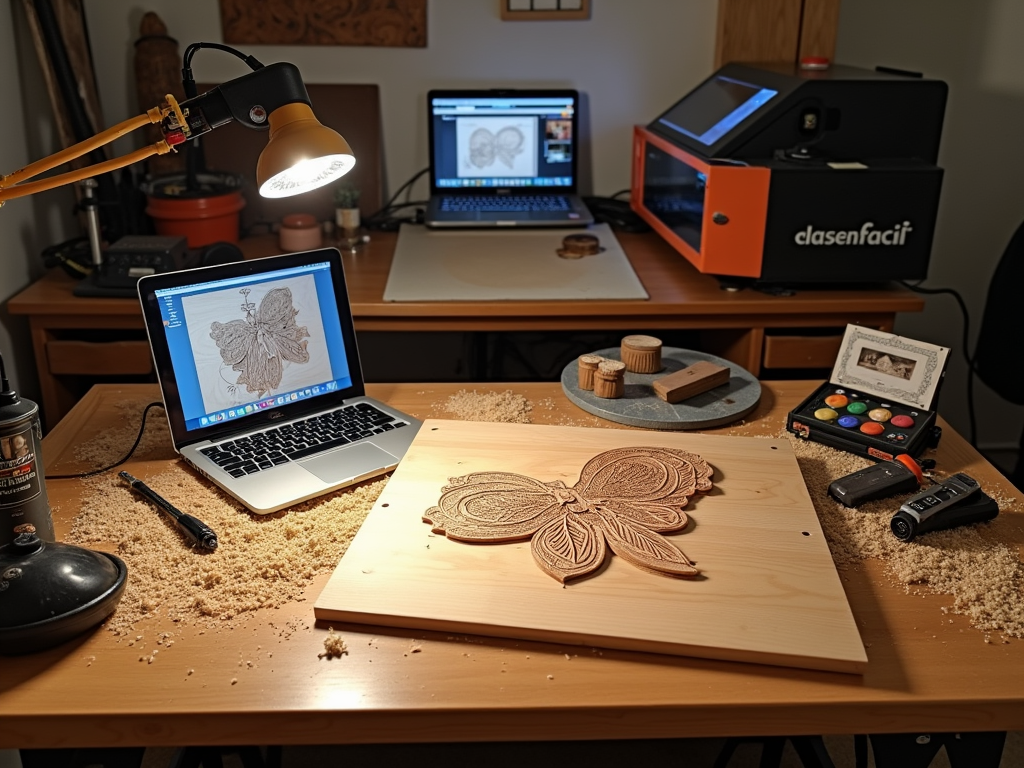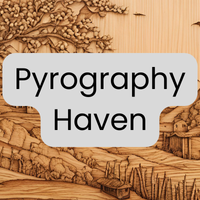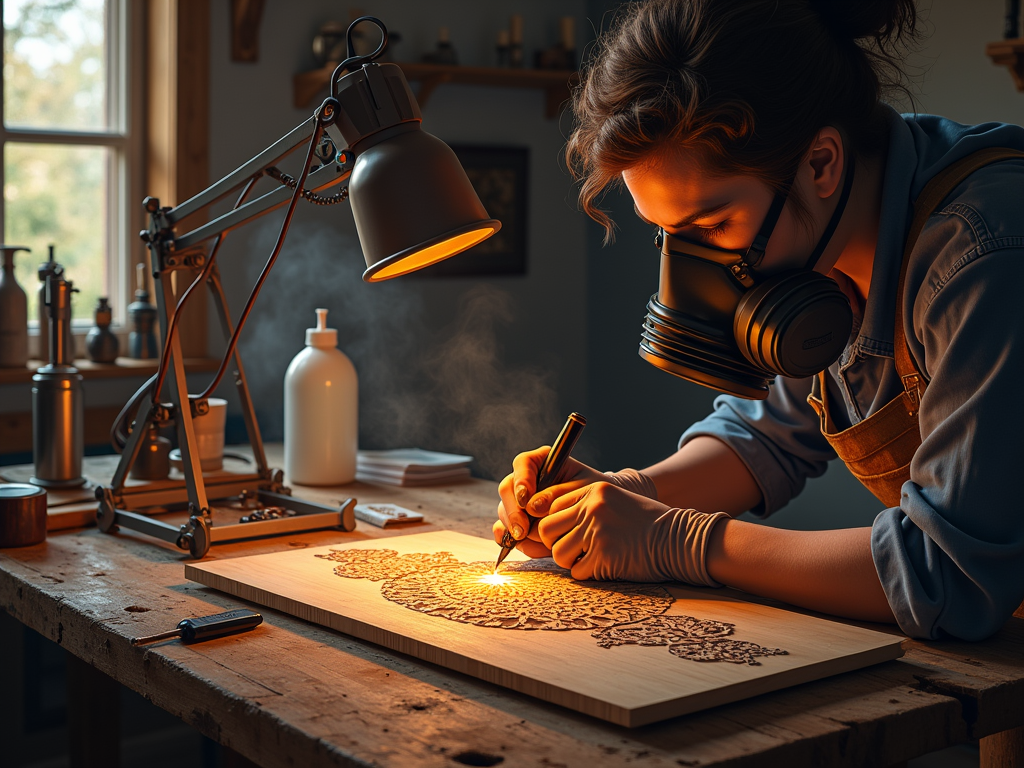Wood burning is a technique within pyrography that focuses on decorating wood with heated tools. Pyrography includes this method but also extends to materials like leather and paper, incorporating advanced techniques such as shading and texturing.
Key Takeaways
- Wood burning applies only to wooden surfaces, while pyrography covers multiple materials.
- Pyrography tools range from wood-burning pens to hot-wire tools and laser engravers, each providing different levels of precision.
- Skill level and detail vary; wood burning suits beginners, whereas pyrography allows for more intricate techniques.
- Cost differences stand out, as wood burning remains more affordable, while pyrography often demands specialized equipment.
- Safety precautions like proper ventilation, gloves, and respirator masks help minimize exposure to harmful fumes when handling heated tools.
Understanding the Art of Decorative Wood Burning
Pyrography covers all forms of burning designs onto wood and other materials. It comes from the Greek words ‘pur’ (fire) and ‘graphos’ (writing). Wood burning, on the other hand, is a specific technique within pyrography focused exclusively on wooden surfaces.
Tools and Methods
Pyrography artists use different tools depending on their style and precision needs:
- Wood burning pens – Ideal for beginners, these come with interchangeable tips for varied effects.
- Hot-wire tools – Offer fine control and higher temperatures for detailed designs.
- Laser engraving – Uses a precision laser for automated and intricate patterns.
Safety Considerations
Working with heated tools requires caution. Always ensure proper ventilation, preferably with a fan or open windows. Protective gear like a respirator mask and gloves helps minimize exposure to smoke and fumes. For more on how these techniques compare, check out this guide.
“`html
Exploring Wood Burning Techniques and Tools
Wood burning is all about using heated tools to create patterns, textures, or images on wood surfaces. This technique relies on controlled heat application to achieve different depths, shades, and details. Soldering irons or specialized woodburning pens come with adjustable temperature settings for precision.
Tools and Techniques for Wood Burning
Different pen tips produce a variety of effects. Fine tips handle delicate line work, while broader tips are better for shading. Calligraphy tips add decorative lettering with ease. Adjusting temperature helps control burn depth, making lighter or darker strokes as needed.
A typical wood burning project follows a few key steps:
- Pattern Transfer: Sketch the design directly or use transfer paper.
- Burning the Design: Start with light strokes, gradually increasing pressure for depth.
- Detailing and Shading: Switch tips or adjust temperature to refine textures.
- Finishing Touches: Sand rough edges and seal the piece with clear varnish for durability.
Comparing popular tools makes a big difference in choosing the right one:
| Tool | Key Features | Temperature Range | Price |
|---|---|---|---|
| Walnut Hollow Creative Versa-Tool | Adjustable temp, multiple tips | 0-950°F | Budget-friendly |
| Razertip Dual Burner | Precision control, quick heat-up | 0-1200°F | Professional-grade |
Understanding how wood burning works makes it easier to explore advanced techniques. If you’re curious about how pyrography differs, check out this comparison on decorative wood burning vs traditional wood burning.
“`
Techniques Beyond Traditional Wood Burning
Pyrography goes beyond basic wood burning by incorporating tools like laser engraving machines and hot-wire pens. These tools unlock more precise designs, deeper textures, and intricate shading.
Laser Engraving for High Precision
Laser engraving removes material without direct manual burning, creating crisp, detailed designs at high speed. This method is perfect for fine lettering, complex patterns, and repetitive designs where consistency matters. Unlike traditional wood burning, laser-engraved artwork maintains sharp edges without burn marks.
Hot-Wire Tools for Texture and Depth
Hot-wire tools allow for unique textures and varied shading effects. By adjusting pressure and temperature, artists can create smooth transitions, fine lines, or deep engravings. These tools give more control over depth, helping to produce realistic details in portraits or landscapes.
Explore more about the difference between wood burning and pyrography to see how these techniques elevate artistic expression.
Comparing Wood Burning and Pyrography
Understanding the Differences
Wood burning falls under the broader category of pyrography. While both involve burning designs onto a surface, pyrography extends beyond just wood and includes leather, paper, and even gourds. Wood burning typically focuses on simpler designs, making it great for beginners or quick projects. Pyrography, on the other hand, incorporates advanced techniques like shading and texturing, allowing for intricate and detailed artwork.
Key Comparisons
To break it down, here’s a quick comparison of the two:
- Cost: Wood burning is generally more affordable due to simpler tools.
- Skill Level: Beginners can start with wood burning, while pyrography often requires more precision.
- Equipment: Basic wood burning kits work for simple designs, whereas pyrography may involve temperature-adjustable tools.
- Applications: Wood burning suits crafts like personalized signs, while pyrography excels in detailed portraits and complex artwork.
Check out more details on the difference between wood burning and pyrography.
Choosing the Best Method for Your Projects
Understanding Your Needs and Skill Level
The right choice depends on budget, skill level, and the detail you want in your work. If you’re starting out, a basic wood burning kit like the Walnut Hollow Value Pyrography Kit is a great option. It’s affordable and lets you practice control and technique. Advanced artists who need precision for intricate designs may prefer the Colwood Detailer Woodburner or even laser engraving for digital accuracy.
Here’s a simple guide:
- Want an affordable and hands-on experience? Go with wood burning.
- Need high precision and fine details? Consider advanced pyrography techniques such as laser engraving.
Learning and Safety Considerations
Online tutorials and workshops can help you master either method. No matter which technique you pick, safety should always come first—work in a well-ventilated space and use heat-resistant gloves. Learn more about the differences between wood burning and pyrography to make an informed choice.

Sources:
Walnut Hollow
Razertip
RZ Mask
Tillman
Colwood

